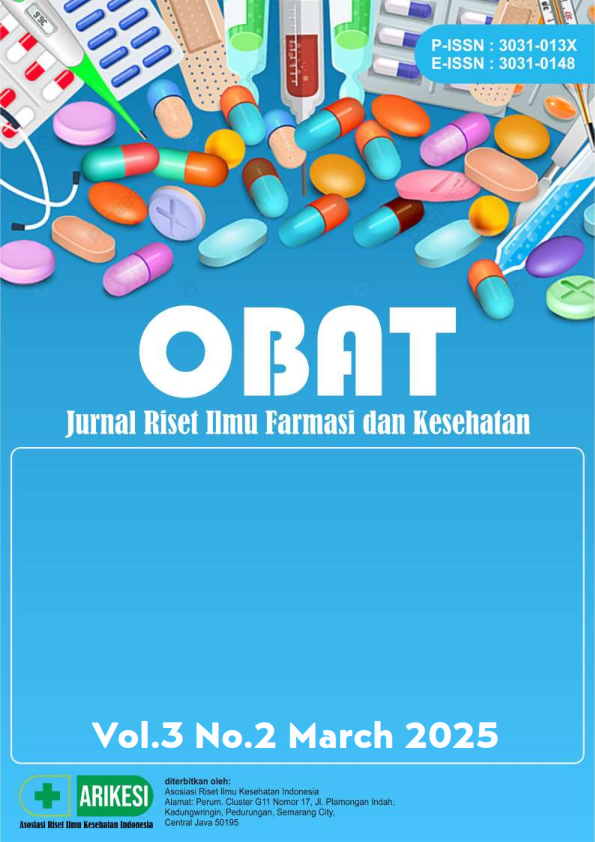An In Vitro Usage of Origanum majorana Watery Extract as Inhibitory Antibacterial Component against Different Medically Important Bacterial Isolates
DOI:
https://doi.org/10.61132/obat.v3i2.1083Keywords:
Adherence Inhibition, Antimicrobial Properties, Biofilm Formation, Floxacin and Origanum majoranaAbstract
Origanum majorana demonstrates a broad spectrum of effectiveness against various diseases, exerting antimicrobial effects against different pathogenic microorganisms. The goals of this research are to provide light on how Origanum majorana extract inhibits human pathogenic bacteria, how it may prevent biofilm development, and how it affects bacterial adhesion. The antibacterial activity of the water-based Origanum majorana extract was assessed in this research using two different methodologies. "Antibiotics were compared to its effectiveness using an agar-well diffusion assay and disc diffusion method," the first step. Additionally, the extract's ability to inhibit biofilm formation and bacterial adherence was assessed through specialized tests. All bacterial isolates of Gram negative, Gram-positive bacterial types were sensitive to Origanum majorana extract and the range of inhibition zone (30 to 24) mm. Although floxacin was effective against some of these isolates, the majority of them were resistant. Most bacterial Gram negative types were exhibit moderate adherence and biofilm activity to this extracts and some bacterial isolated of bacteria were exhibit high adherence and biofilm activity to the watery extracts of Origanum majorana. This research confirms previous findings that Origanum majorana extracts are very effective against a wide variety of clinical isolates of bacteria, including Gram-negative as well as Gram-positive varieties. Notably, the extracts were found to be more effective than commercially available antibiotics. Furthermore, the extracts displayed significant inhibition of bacterial adherence and biofilm formation. Based on these findings, Origanum majorana extracts have great promise as an effective antibacterial and anti-biofilm agent.
Downloads
References
Ávila-Campos, M. J., Simionato, M. R. L., Cai, S., Mayer, M. P. A., De Lorenzo, J. L., & Zelante, F. J. P. O. B. (2000). Virulence factors of Actinobacillus actinomycetemcomitans: other putative factors. 14, 05-11.
Ben Salha, G., Herrera Díaz, R., Lengliz, O., Abderrabba, M., & Labidi, J. J. M. (2019). Effect of the chemical composition of free-terpene hydrocarbons essential oils on antifungal activity. 24(19), 3532.
Forbes, B. A., Sahm, D. F., & Weissfeld, A. S. (2007). Diagnostic microbiology: Mosby St Louis.
Ghazal, T. S. A., Schelz, Z., Vidács, L., Szemerédi, N., Veres, K., Spengler, G., & Hohmann, J. J. P. (2022). Antimicrobial, multidrug resistance reversal and biofilm formation inhibitory effect of Origanum majorana extracts, essential oil and monoterpenes. 11(11), 1432.
Hindi, N., Yasir, A., Al-Mahdi, Z., & Jebur, M. H. J. I. J. P. R. (2016). Evaluation of antibacterial activity: anti adherence, anti biofilm and anti swarming of the aquatic extract of black raisins and vinegar of black raisins in Hilla City, Iraq. 9(9), 271-280.
Hindi, N. K. J. A. j. o. p., & Therapeutics, C. (2013). In vitro antibacterial activity of aquatic garlic extract, apple vinegar and apple vinegar-garlic extract combination. 1(1), 42-51.
Hindi, N. K. K., Al-Mahdi, Z. K. A., & Chabuck, Z. A. G. J. P. (2014). Antibacterial activity of the aquatic extractof fresh, dry powder ginger, apple vinegar extract of fresh ginger and crud oil of ginger (zingiberofficinale) against different types of bacteria in Hilla City, Iraq. 3(6).
Pernin, A., Guillier, L., & Dubois-Brissonnet, F. J. F. m. (2019). Inhibitory activity of phenolic acids against Listeria monocytogenes: deciphering the mechanisms of action using three different models. 80, 18-24.
Shakya, A. K. J. I. j. o. h. m. (2016). Medicinal plants: Future source of new drugs. 4(4), 59-64.
Szemerédi, N., Kincses, A., Rehorova, K., Hoang, L., Salardón-Jiménez, N., Sevilla-Hernández, C., . . . Spengler, G. J. A. (2020). Ketone-and cyano-selenoesters to overcome efflux pump, quorum-sensing, and biofilm-mediated resistance. 9(12), 896.
Tripathy, B., Satyanarayana, S., Khan, K. A., Raja, K. J. I. J. o. P. R., & Sciences, H. (2017). An updated review on traditional uses, taxonomy, phytochemistry, pharmacology and toxicology of Origanum majorana. 5(4), 1717-1723.
Vasireddy, L., Bingle, L. E., & Davies, M. S. J. P. O. (2018). Antimicrobial activity of essential oils against multidrug-resistant clinical isolates of the Burkholderia cepacia complex. 13(8), e0201835.
Wang, S., Zhou, L., Attia, F. A.-Z. K., Tang, Q., Wang, M., Liu, Z., . . . Kang, W. J. F. i. N. (2021). Origanum majorana L.: a nutritional supplement with immunomodulatory effects. 8, 748031.
Zeouk, I., Ouali Lalami, A., & Bekhti, K. J. A. J. P. C. R. (2019). In vitro antibacterial activity of medicinal plants in the central north of Morocco: a possible source of alternative drugs against methicillin-resistant Staphylococcus aureus. 12, 285-292.
Downloads
Published
How to Cite
Issue
Section
License
Copyright (c) 2025 OBAT: Jurnal Riset Ilmu Farmasi dan Kesehatan

This work is licensed under a Creative Commons Attribution-ShareAlike 4.0 International License.





